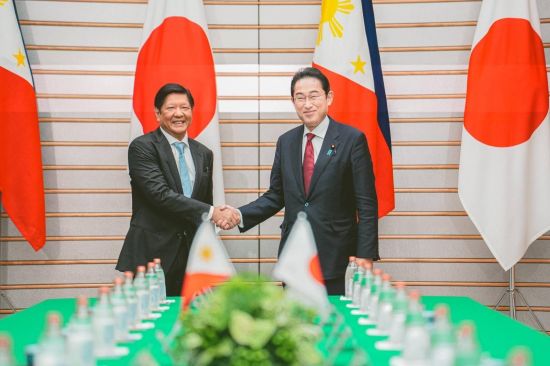As it seeks to balance its relations with China and the US, the Philippines under President Ferdinand Marcos Jr has been deepening its ties with Japan. Aaron Jed Rabena of the Asia Pacific Pathways to Progress and Philippine Council for Foreign Relations examines the growing Philippines-Japan partnership.
Marcos on the move: The president returns to Manila after his five-day state visit to Japan (Credit: Presidential Communications Office)
In February, Philippine President Ferdinand “Bongbong” Marcos Jr concluded a state visit to the world’s third richest economy, Japan. It was the second state visit of his administration. Marcos followed the lead of his predecessor, Rodrigo Duterte, in making a trip to Japan after China, to which he traveled in early January. Japan is important to the Philippines as it is one of the country’s only two strategic partners apart from Vietnam. The Philippines’ National Security Policy (NSP) recognizes Japan as a major economic power and the Philippine National Defense Strategy (NDS) classifies Japan as a “security partner” for education capacity-building, defense equipment and technology, humanitarian assistance and disaster relief (HA/DR), and maritime security.
All post-World War II Philippine presidents have maintained robust relations with Japan. In recent years, then President Gloria Macapagal Arroyo forged the Japan-Philippine Economic Partnership Agreement (JPEPA) and her successor, the late Benigno Aquino III, upgraded bilateral ties to a “strategic partnership”. More recently, former president Duterte, who visited Japan five times, called the Philippines’ northern neighbor “a true friend closer than a brother” and instituted new bilateral mechanisms such as the Japan-Philippines Foreign and Defense Ministerial (2+2) Meeting and Joint Committee on Infrastructure Development and Economic Cooperation. When then Japanese prime minister Abe Shinzo relinquished his post in 2020 due to an illness, the Duterte administration called him Japan’s “best postwar prime minister”.
For Marcos Jr, Japan is a “solid and steadfast partner” of the Philippines. Economically, Japan has been the Philippines’ perennial top source of official development assistance (ODA), second largest trade partner, and one of the top ten destinations for Overseas Filipino Workers (OFWs), with over 300,000 in the country. Throughout the years, most of Japan’s ODA had gone into transportation, energy (electric power and gas), irrigation and flood control projects. Notably, Japan bagged the most number of flagship projects under the Duterte government’s “Build, Build, Build” infrastructure program, followed by China.
Major projects funded by Japan include the Metro Manila Subway and the North-South Commuter Railway. Besides these, Japan has actively supported peace-building programs in the Philippines’ Muslim Mindanao through the Japan-Bangsamoro Initiatives for Reconstruction and Development (J-BIRD). Remarkably, a year before the end of Duterte’s term, the Japanese government announced that it was able to deliver on its pledge of development assistance and private investments amounting to US$3.6 billion over the past five years.
Socio-culturally, Japanese soft power is very strong in the Philippines. As many as 81 percent of Filipinos have a favorable opinion of Japan which is evident as the country is the top holiday destination of Filipinos, Japanese food is the second-most favorite foreign cuisine, and Filipinos are very fond of Japanese pop culture (e.g., anime, video games and cosplay). In fact, it is because of the very warm attitude of Filipinos towards Japan and huge Japanese pop-culture fanbase that Japanese film makers have opted to launch their Asian premier viewing in the Philippines. Moreover, Japanese technology or “Made in Japan” goods such as cars, gadgets and appliances are by default seen as high-quality, and this reputation has spilled over to Japanese-made infrastructure. These factors have had such a positive impact on the perception of Japan in the Philippines that issues about Imperial Japan’s World War II offenses and atrocities have been virtually forgotten.
Japan is the second-most trusted country in the Philippines after the US. In a December 2022 Pulse Asia Survey, more than half of the people polled wanted the Marcos administration to bolster security ties with Japan on the South China Sea. Japan has served as an observer in Philippines-US military exercises such as Balikatan and Kamandag. From that foundation, there has been deepening trilateral policy coordination among Manila, Tokyo and Washington, with expanding activities such as the Philippines-US-Japan Trilateral Defense Policy Dialogue (TDPD), Japan-Philippines-United States Land Forces Chiefs Meeting, and Joint Maritime Law Enforcement Training involving the Philippine, US and Japanese coast guards.
For its part, the Japanese are seeking strategic balancing partners such as the Philippines, given their longstanding territorial and maritime disputes with China in the East China Sea. Tokyo has been vocal in its support of the 2016 arbitral judgement in favor of the Philippines, which rejected China’s sovereignty claims in the South China Sea. With the very positive view of Japan among Filipinos and the momentum of constructive relations over decades, it is thus not surprising that the Philippines welcomes a remilitarized Japan just as it had once indicated support for Tokyo to be given a permanent seat on the United Nations Security Council.
During Marcos Jr.’s visit to Japan, both sides reaffirmed the importance of a “free and open Indo-Pacific” (FOIP), a pillar concept in Japanese foreign policy, and agreed to expand cooperation on agriculture, digital economy, manufacturing, healthcare, renewable energy, 5G and artificial intelligence, among other areas. Japan additionally extended ODA and loans for Philippine infrastructure development. The total pledges from Japan, including investments, amounted to US$13 billion.
For smaller powers such as the Philippines, engaging with middle powers including Japan serves as an alternative to the stark choices that might have to be made in the context of the China-US great power rivalry. But Tokyo’s alliance with Washington, combined with the Philippines’ own deepening security ties with the US, will test Manila’s skillfulness in balancing relations with Beijing. Going forward, in addition to the South China Sea, which is already on their joint security agenda, Taiwan could become a matter of common concern to the budding strategic partners as Washington “sets the theater” for a potential conflict with China in Asia.
Further reading:
Aaron Jed Rabena
Asia Pacific Pathways to Progress and Philippine Council for Foreign Relations
Check out here for more research and analysis from Asian perspectives.



